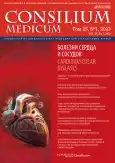Anticoagulant therapy in a hemodialysis patient at high risk of thrombotic and hemorrhagic complications. Case report
- Authors: Orudzheva S.A.1, Kudryavtsev A.N.1, Demidova V.S.1, Ushakov A.A.1, Magomedova S.D.1, Mitish V.A.1,2,3, Kuprin A.V.1, Bozheva E.I.1
-
Affiliations:
- Vishnevsky National Medical Research Center of Surgery
- Research Institute of Emergency Pediatric Surgery and Traumatology
- People’s Friendship University of Russia (RUDN University)
- Issue: Vol 25, No 1 (2023): Cardiovascular diseases
- Pages: 39-45
- Section: Articles
- URL: https://journals.rcsi.science/2075-1753/article/view/131637
- DOI: https://doi.org/10.26442/20751753.2023.1.201951
- ID: 131637
Cite item
Full Text
Abstract
An attempt to preserve the knee joint in a patient on hemodialysis with stage IV lower limb ischemia with a high risk of thrombotic and hemorrhagic complications is presented. Multifocal atherosclerosis and extensive occlusion of the arteries of the lower leg ruled out the technical possibility of revascularization. The patient refused the proposed hip amputation. An attempt was made to perform amputation at the level of the lower leg. Required therapy aimed at the treatment and prevention of thrombotic complications, and optimization of microcirculation in the ischemic limb. For this purpose, a prolonged blockade of the sciatic and femoral nerves, combined anticoagulant therapy, and treatment with alprostadil were performed. Therapy with antithrombotic and vasoactive drugs was not effective and was complicated by the state of persistent hypocoagulation with an episode of bleeding. Amputation of the limb at the level of the thigh was performed according to vital indications after correction of hypocoagulation. The lack of clinical recommendations on anticoagulant therapy for critical lower limb ischemia in patients with stage 5 chronic kidney disease requires an individual approach to the choice of antithrombotic drugs and their doses, monitoring the state of blood coagulation using an integral method for assessing the hemostasis system – thromboelastography.
Full Text
##article.viewOnOriginalSite##About the authors
Saida A. Orudzheva
Vishnevsky National Medical Research Center of Surgery
Author for correspondence.
Email: Osaida@rambler.ru
ORCID iD: 0000-0002-0212-5742
D. Sci. (Med.)
Russian Federation, MoscowAnton N. Kudryavtsev
Vishnevsky National Medical Research Center of Surgery
Email: Osaida@rambler.ru
ORCID iD: 0000-0002-6149-189X
Cand. Sci. (Med.)
Russian Federation, MoscowValentina S. Demidova
Vishnevsky National Medical Research Center of Surgery
Email: Osaida@rambler.ru
ORCID iD: 0000-0003-3187-4408
D. Sci. (Biol.)
Russian Federation, MoscowAlexandr A. Ushakov
Vishnevsky National Medical Research Center of Surgery
Email: Osaida@rambler.ru
ORCID iD: 0000-0002-1858-9744
Surgeon
Russian Federation, MoscowSamera D. Magomedova
Vishnevsky National Medical Research Center of Surgery
Email: Osaida@rambler.ru
ORCID iD: 0000-0002-7068-7421
Surgeon
Russian Federation, MoscowValery A. Mitish
Vishnevsky National Medical Research Center of Surgery; Research Institute of Emergency Pediatric Surgery and Traumatology; People’s Friendship University of Russia (RUDN University)
Email: Osaida@rambler.ru
ORCID iD: 0000-0001-6411-0709
Cand. Sci. (Med.)
Russian Federation, Moscow; Moscow; MoscowAlexey V. Kuprin
Vishnevsky National Medical Research Center of Surgery
Email: Osaida@rambler.ru
ORCID iD: 0000-0002-5017-9745
Cand. Sci. (Med.)
Russian Federation, MoscowElena I. Bozheva
Vishnevsky National Medical Research Center of Surgery
Email: Osaida@rambler.ru
ORCID iD: 0000-0003-2126-8885
Surgeon
Russian Federation, MoscowReferences
- Si-Tong Li, Chao Jiang, Chao Jiang, et al. Chronic kidney disease and risks of adverse clinical events in patients with atrial fibrillation. J Geriatr Cardiol. 2021;18(11):867-76. doi: 10.11909/j.issn.1671-5411
- Lutz J, Menke J, Sollinger D, et al. Hemostasis in chronic kidney disease. Nephrol Dial Transplant. 2014;29:29-40. doi: 10.1093/ndt/gft209
- Casserly LF, Laura M. Thrombosis in end-stage renal disease. Dember Resources Review Semin Dial. 2003;16(3):245-56. doi: 10.1046/j.1525-139x.2003.16048.x
- Ocak G, Lijfering WM, Verduijn M, et al. Risk of venous thrombosis in patients with chronic kidney disease: identification of high-risk groups. Thromb Haemost. 2013;11(4):627-33. doi: 10.1111/jth.12141
- Ocak G, Jay van Stralen K, Roosendahl FR, et al. Mortality due to pulmonary embolism, myocardial infarction, and stroke among incident dialysis patients. J Thromb Haemost. 2012;10(12):2484-93. doi: 10.1111/j.1538-7836.2012.04921.x
- Garimella PS, Hart PD, O'Hare A, et al. Peripheral Artery Disease and CKD: A Focus on Peripheral Artery Disease as a Critical Component of CKD. Care Practice. 2012;60(4):641-54. doi: 10.1053/j.ajkd.2012.02.340
- Ito S, Osaka M, Higuchi Y, et al. Indoxyl sulfate induces leukocyte-endothelial interactions through up-regulation of E-selectin. Biol Chem. 2010;285(50):38869-75. doi: 10.1074/jbc.M110.166686
- Pletinck A, Glorieux G, Schepers E, et al. Protein-bound uremic toxins stimulate crosstalk between leukocytes and vessel wall. J Am Soc Nephrol. 2013;24(12):1981-94. doi: 10.1681/ASN.2012030281
- Jacobi J, Porst M, Cordasic N, et al. Subtotal nephrectomy impairs ischemia-induced angiogenesis and hindlimb re-perfusion in rats. Kidney Int. 2006;69(11):2013-21. doi: 10.1038/sj.ki.5000448
- Lano G, Burtey S, Sallée M, et al. Indoxyl Sulfate, a Uremic Endotheliotoxin. Toxins (Basel). 2020;12(4):229. doi: 10.3390/12040229
- Момот А.П., Цывкина Л.П., Тараненко И.А., и др. Современные методы распознавания тромботической готовности: монография. Барнаул: Изд-во Алтайского ун-та, 2011; c. 138 [Momot AP, Cyvkina LP, Taranenko IA et al. Sovremennyie metody raspoznavaniia tromboticheskoi gotovnosti: monografiia. Barnaul: Izd-vo Altaiskogo un-ta, 2011; p. 138 (in Russian)].
- Синьков С.В., Заболотских И.Б., Шапошников С.А. Приобретенные коагулопатии: современные подходы к дифференциальной диагностике и интенсивной терапии с позиций доказательной медицины. Общая реаниматология. 2007;III(5-6):192-8 [Sinkov SV, Zabolotskikh IB, Shaposhnikov SA. Acquired Coagulopathies: Current Approaches to Differential Diagnosis and Intensive Care in the Context of Evidence-Based Medicine. Obshchaia reanimatologiia. 2007;III(5-6):192-8 (in Russian)].
- Lasierra-Cirujeda J, Coronel P, Aza M, et al. Use of sulodexide in patients with peripheral vascular disease. J Blood Med. 2010;1:105-15. doi: 10.2147/JBM.S10558
- Gaddi A, Galetti C, Illuminati B, et al. Meta-analysis of some results of clinical trials on sulodexide therapy in peripheral occlusive arterial disease. J Int Med Res. 1996;24(5):389-406. doi: 10.1177/030006059602400501
- Broekhuizen LN, Lemkes BA, Mooij HL, et al. Effect of sulodexide on endothelial glycocalyx and vascular permeability in patients with type 2 diabetes mellitus. Diabetologia. 2010;53:2646-55. doi: 10.1007/s00125-010-1910-х
- Carroll BJ, Piazza G, Goldhaber SZ. Sulodexide in venous disease. J Thromb Haemost. 2019;17(1):31-8. doi: 10.1111/jth.14324
Supplementary files












